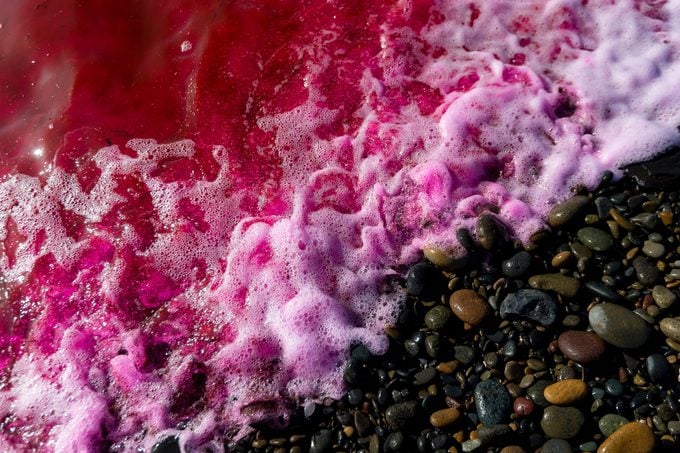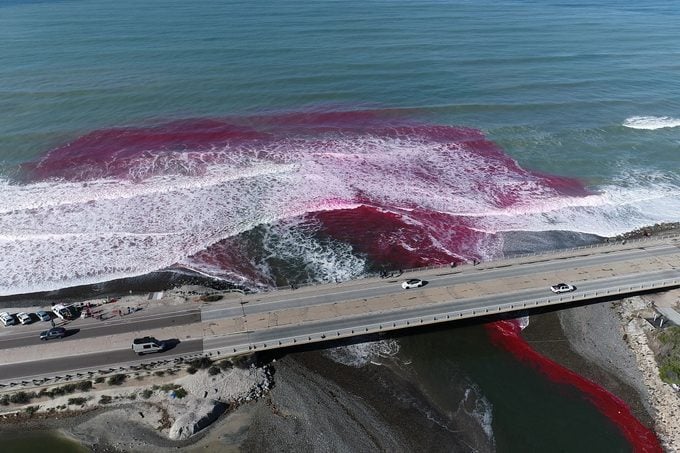If You See Pink Waves, This Is What It Means
Updated: Feb. 07, 2023

Off the California coastline, fluorescent water is making waves.
If you live in San Diego, you may have noticed some strangely colored water at the beach recently. And while the pink-hued ocean may have you wondering about algal blooms, as with pink snow or red tide, it’s actually an intentional dye job. Here’s everything you need to know about the fuchsia phenomenon, including why it’s happening, when to expect it to subside and if it’s environmentally safe.
Why Is the Water Pink?

Scientists at the University of California, San Diego’s Scripps Institution of Oceanography and the University of Washington have teamed up to run an experimental study on how small freshwater outflows interact with the ocean’s surfzone. The project has been aptly titled “PiNC,” or Plumes in Nearshore Conditions.
PiNC is focused on the estuary and coastline at Los Peñasquitos Lagoon, a nature reserve outside of San Diego. Three freshwater creeks feed into the lagoon—Carmel Creek, Carroll Creek and Los Peñasquitos Creek—which, in turn, feed into the Pacific Ocean. Researchers have thus dropped the pink dye into the mouth of the estuary during ebb tides in order to track its journey out to the ocean.
How Long Will the Water Be Pink?
Scientists have released the dye in three rounds. The first drop was on Jan. 20, 2023, and the second was on Feb. 1, 2023. The third drop has not yet happened but is scheduled for sometime this month. The dye is visible to the naked eye for several hours after the drop and largely dissipates within 24 hours.
How Are Researchers Tracking the Pink Water?
The PiNC team is using numerous instruments, including drones, sensors attached to poles inserted into the sand at the surfzone, a fluorometer on a jet ski and sensors on the ocean floor. These devices will help the scientists measure not only the levels of light emitted from the dye at various stages in its migration, but also the water’s salinity, tides, temperatures, and wave height. All of this data will provide a holistic picture of the water’s movement and the freshwater plume’s absorption into the ocean.
Is the Pink Water Safe?
The pink dye is completely nontoxic and poses no threats to the watershed or the humans and wildlife that live there. However, if you reside in the San Diego area, researchers are asking potential beachgoers to avoid the estuary on the dye drop dates, so as not to interfere with the experiment.
What Is the Significance of the Pink Dye Experiment?

While pink dye has been used to track the interactions between fresh- and saltwater before, the PiNC study is the first of its kind in this particular location. Researchers state that similar existing oceanographic studies have focused predominantly on large-scale freshwater plumes, not on small- and moderate-scale ones like that at Los Peñasquitos.
In the words of Alex Simpson, a postdoctoral candidate at Scripps and member of the PiNC team, “Los Peñasquitos Lagoon is a very dynamic system, with different elements changing each day, often even over the course of one day…I am looking forward to seeing how the balance of physical forces—ocean waves competing against river outflow—determine the fate of the estuary water as it enters the coastal ocean.”
Because rivers carry important materials such as sediment, pollutants and larvae out to the ocean, tracking the flow of the pink water will ultimately help scientists understand how these materials get distributed in our ecosystems.
Sources:
- Scripps Institution of Oceanography: Plumes in Nearshore Conditions
- PopSci: Gnarly pink waves crash near San Diego






















